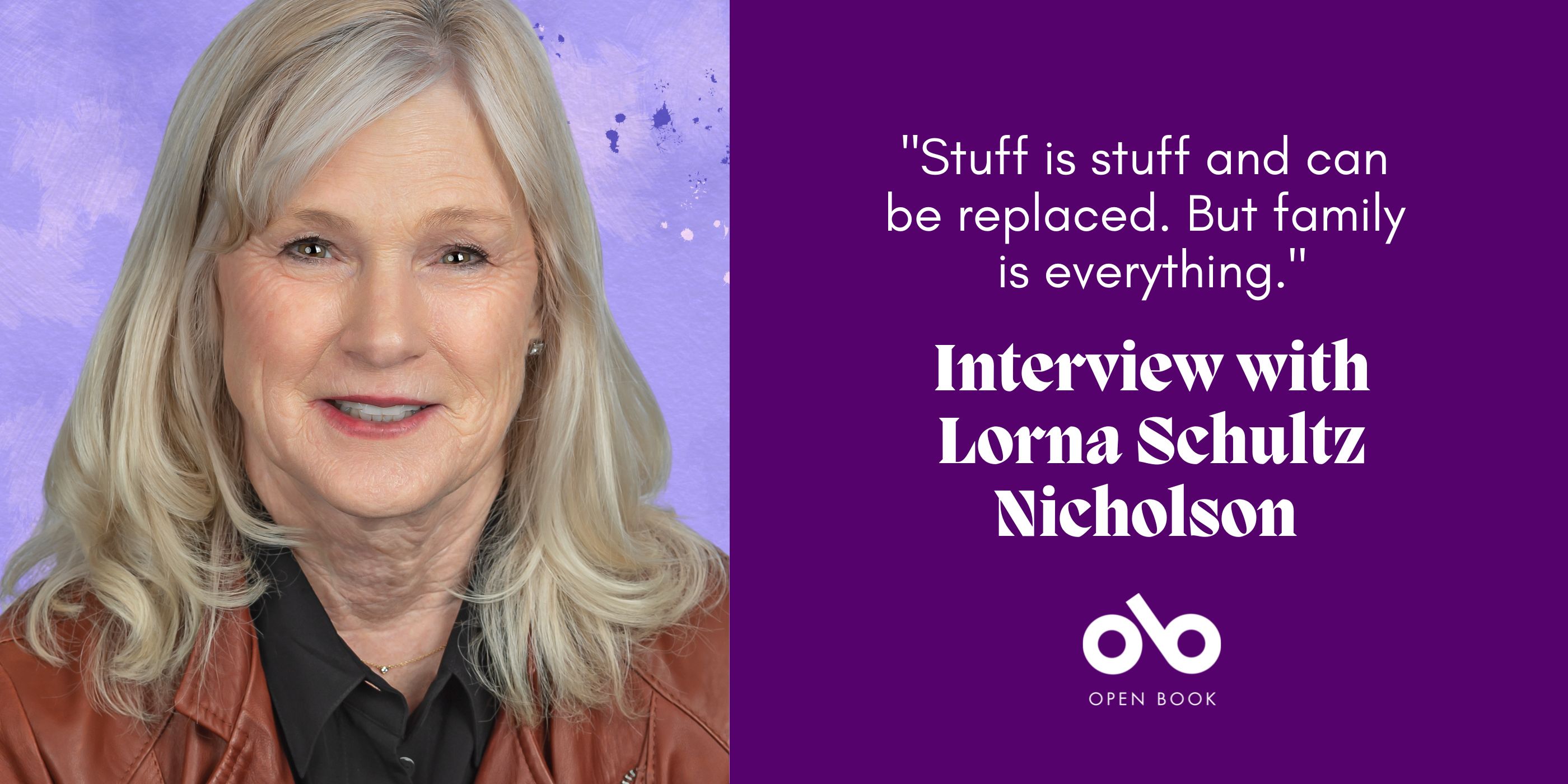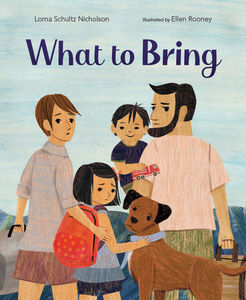Lorna Schultz Nicholson on Writing a Picture Book That Encourages Kids to Think About What They Most Value
If you had only a few minutes to gather the things you love most from your home before fleeing, what would you take?
This difficult decision is at the centre of Lorna Schultz Nicholson's powerful picture book, What to Bring (forthcoming March 2023 from Owlkids, illustrated by Ellen Rooney), where we meet Malia, a sweet and tough little girl out for a day of play with her family.
When massive grey clouds cover the sky and the air begins to smell strange, her parents quickly realise that a forest fire is rippling through their area and they need to evacuate. They tell Malia to pack up her favourite things to bring with her, but the choice feels impossible. When Malia realises exactly what she most wants to keep with her, she learns a lot about herself and her values.
Moving and anchored in an authentic and lovable main character, What to Bring tackles tough subjects—from family to climate change—with heart and a deft touch that allows kids to engage with complex questions through a gentle narrative.
Nicholson has written for kids of all ages, including picture books, middle grade, and young adult literature, and has earned numerous OLA Forest of Reading and other awards nominations for her work. We're speaking with her today about the book and how she created Malia's story. She tells us about the frightening, real-life experience that inspired the book's premise, the goosebump-inducing moment of seeing illustrator Ellen Rooney's artwork for the book for the first time, and the tasty treats that work as mini-rewards during her writing process.
Open Book:
Tell us about your new book and how it came to be.
Lorna Schultz Nicholson:
In the summer of 2020, in Penticton, British Columbia, a forest fire started in the area behind our neighbourhood. Hours later, we were evacuated, and this real-life experience gave me inspiration for What to Bring. As I packed my bag for the evacuation, I took the funniest things, shorts to wear but not one t-shirt. I have no idea why I did that, the quickness of having to leave perhaps. That is why the book is titled What to Bring. This title also comes from my five-year-old neighbour who wanted to bring all her shoes. Her mother told me about this after we had all returned home to houses that didn’t burn down because of our amazing firefighters. This mother told her daughter to take three pairs of shoes, her favourite ones.
Another reason I wrote the book, and perhaps the biggest takeaway for the reader, was the realization of the bigger picture. My husband and I stayed with friends across the lake from our house, and on that first night I sat on a dock and watched the fire progress as the wind continued to blow. Finally, at one o’clock in the morning, I thought about what would happen if we lost our house. Yes, it was my house, but my children were safe, my dogs were safe, my husband was with me. People and pets were what mattered. That moment was so strong for me that I went to bed and slept until morning. I wanted to write a book about how stuff is stuff and can be replaced. But family is everything.
OB:
Did the book look the same in the end as your originally envisioned it when you started working, or did it change through the writing process?
LSN:
This was a book that went through many, many drafts. I wrote and rewrote. The first few drafts were too adult as I took it from my point of view as that was my point of reference. I needed to change how I was writing the book and come from a child’s perspective. A child wouldn’t have the life experiences that I had and would be so confused and frightened. I made sure I talked to my neighbours about how their children had reacted, their emotions about having to leave, their fears, what they wanted to take with them. Once I felt it was from a child’s perspective I sent to my agent. Then she made a few changes. After it was picked up my Owlkids (I was thrilled) it went through many more changes with my editor, Jennifer Stokes. She was brilliant. But there was one line in there I wanted to keep, and she kept telling me that perhaps it had to come out. (She was very nice about it.) I kept putting it in and she kept talking to me about how it might have to come out. Of course, I finally realized that she was right. It would have been too much and perhaps not a childlike line, and it also wasn’t subtle. So, yes, this book went through many, many changes.
Your CanLit News
Subscribe to Open Book’s newsletter to get local book events, literary content, writing tips, and more in your inbox
OB:
What was the strangest or most memorable moment or experience during the writing process for you?
LSN:
My most memorable moment was seeing the illustrations for the first time. Ellen Rooney did such a beautiful job with Malia, her family, the fire in the background, that I almost cried. To see your words in pictures is always memorable and an incredible rush. Ellen gave it a beautiful flowing softness with her colour choices, but she didn’t take anything away from the severity of the situation. And her incredible details, including fridge magnets, and the cat that appears here and there, were so subtle and made the book one that can be read again and again. I saw something new every time I read it. I also loved the page where she had Malia hiding as it is so childlike. Malia’s facial reactions are perfect, and she captured her age so well. She got that child element to the story.
OB:
What do you need in order to write – in terms of space, food, rituals, writing instruments?
LSN:
I write on my computer, and I don’t need a lot of space. Just a small area with a desk for my computer and room for a notebook. I need the notebook for my scribbles as I often make notes/scribbles as I go, especially if I’m stumped. But I like quiet when I write. No music. I know some authors love to write with music, but that’s not for me. I also love an empty house, just me and my dog. But I can write with the door closed if I’m under a deadline. I like to sit in front of a window as well, as looking outside when I’m thinking helps me visualize where I want to go with the project. I love a good cup of coffee and sometimes I will eat candy like Skittles or M & M’s. Or... those Mini Eggs. They are addicting and I convince myself not to buy them when I’m the grocery store. It’s an ongoing battle when I’m in the middle of a project. Lol.
OB:
Do you feel like there are any misconceptions about writing for young people? What do you wish people knew about what you do?
LSN:
So many people think that writing for young people must be easy, especially picture books because they are so short. But they are hard. You go through so many edits to make sure that every single word is right and that the story will appeal to a child. The story needs to have a subtle message and can’t be didactic. It must speak to the child instead of the adult. It has to be light but not too light. Or perhaps the story is dark but can’t be too dark. The balance in a picture book is incredibly tricky. So many children’s books speak to the adult and don’t understand how children feel in different situations. They need to speak to the child, understanding all of their complicated emotions, but also their lack of wisdom, without speaking down to them. They are not easy.
OB:
How would you describe the writing community in Canada in terms of authors writing for young people? What strengths and weaknesses do you observe within the community?
LSN:
We have a wonderful children’s writing community in Canada. I think we are blessed. The support is amazing, and other writers are so encouraging. Plus, we have so many brilliant authors and Canadian children’s books are good literature. I wish more schools would use Canadian books in their curriculum.
OB:
What are you working on now?
LSN:
I am working on another picture book. Yeah. I love picture books. They are fun and hard and challenging and thought provoking. I’m learning so much about words, how to string them together, how to take words out, use a better word. They’re like a puzzle. I’m also working on a middle grade novel that will be published in the fall of 2024 and I also love writing novels, the longer length. I love writing in different genres as it keeps me learning and growing as a writer. To me that’s important because I love what I do!
_________________________________________
Lorna Schultz Nicholson is the author of several picture books, middle grade fiction, YA fiction, and nonfiction hockey books. Her books have been nominated for the Ontario Library Association Forest of Reading Red Maple, Red Cedar, and Yellow Cedar awards, the MYRCA award, the Alberta Literary Guild award, and the Saskatchewan Willow awards. She is a frequent presenter in schools, writing workshops, and conferences. She lives in Edmonton, Alberta.





